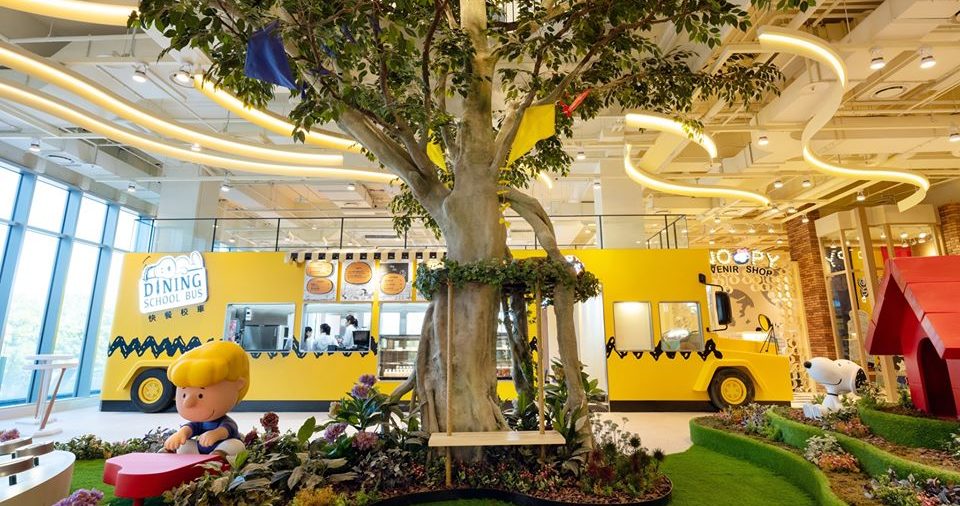Two recent Peanuts-themed projects in Asia – the new ‘Snoopy Garden’ in South Korea with its restful outdoor space and engaging indoor features, and the Peanuts-themed guest rooms, dining and activities at the Fame Hall Garden Hotel in Taiwan – sparked our curiosity about the continued popularity of Peanuts in the LBE sector. InPark posed a half-dozen interview questions to Craig Herman, Senior Director, Category Management, PEANUTS™ Worldwide LLC.
Interview with Craig Herman by Judith Rubin and Joe Kleiman
The Peanuts IP seems to be universally adaptable to consumer experiences. Please share something about the collaboration and design choices of integrating the IP into these two, recent new projects in Korea and Taiwan.
The project in Taiwan represents an exciting partnership and one which has been in development for 3 years. Fame Hall Garden Hotel features the only spherical building with a diameter of 32 meters in Asia, literally baseball-shaped. Hung Teng-sheng, the “father of professional baseball,” is the founder of Brother Elephants, the chairman of Brother Hotel Taipei and the visionary behind Fame Hall. Baseball plays an integral part in Peanuts strips and Fame Hall is the perfect fit for Mr. Teng-Sheng’s vision, a place where baseball is celebrated and kids of all ages can engage in Peanuts skill-based games while learning the art of the game itself.
‘Snoopy Garden’ is the first of its kind, “relaxing Zen garden” featuring a well-curated welcome center designed to introduce guests to the world of Peanuts through five different “halls” that reveal the intricacies of the strips and characters’ relationships to each other. Opening up to the 20-acre garden area, guests are invited to enjoy the natural landscape in the relaxing atmosphere in the way that Snoopy would, taking in the joy of nature and celebrating the stunning and unique beauty that is JeJu Island.
Can you tell us more about the popularity of Peanuts in Asia?
Asia and Japan have always been very welcoming to Snoopy and Peanuts. From women who enjoy Peanuts apparel and children and families enjoying the delights at Universal Studios Japan, the territory continues to be a key driver in Peanuts continuing success story. In recent years, Peanuts has enhanced a number of exciting and unique experiences – from Chinese Lantern Festivals celebrating “Year of the Dog,” family “fun runs,” the expansion of Peanuts cafes and restaurants in Hong Kong and across Japan, mall activations, and the addition of themed parks and attractions like Snoopy Garden and Baseball Hall of Fame… and we’re just getting started.
How did the NASA collaboration come about? Is the “Snoopy in Space” series being well received?
The Peanuts and NASA relationship dates back to the Apollo missions of the 1960s, when astronauts used the call names Snoopy and Charlie Brown to designate the lunar module and command module respectively, in the Apollo 10 practice mission. Snoopy has enjoyed a long affinity within the Agency, with the prestigious Silver Snoopy award still being given out to employees today. In 2018, Peanuts Worldwide signed a Space Act Agreement with NASA, with the goal of bringing STEM education and an interest in space travel to today’s children. “Snoopy in Space,” currently streaming on Apple TV+ has been nominated for a Daytime Emmy in Outstanding short format children’s program.
Perhaps Peanuts is just the right thing to give us optimism and comfort in COVID times….
The beauty of Peanuts is that it speaks to human nature and the highs and lows of the human experience. Though the characters live in their own world and timeline, they still provide a daily dose of comfort that is as meaningful today as when Charles Schulz first drew them in 1950.
A number of Peanuts museums and installations feature modernist architecture and a white color scheme. Is that serendipitous or is it part of the branding, or evocative of the Peanuts comic strip heyday of the 50s and 60s?
The installations and design choices are evocative of the minimalist approach that Schulz took with the strip. Drawing only what’s necessary, Schulz’s perceived simplicity was a veiled sophistication that never pandered to his audience so that the appeal worked on so many levels and for all age groups.
TOP OF PAGE: Kite Eating Tree. Courtesy Baseball Hall of Fame, Taiwan











